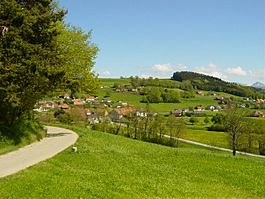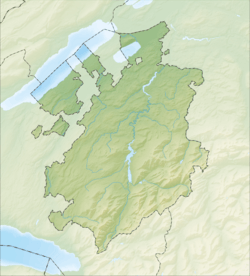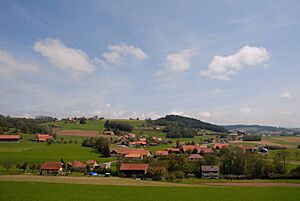Vuarmarens facts for kids
Quick facts for kids
Vuarmarens
|
||
|---|---|---|

Vuarmarens village
|
||
|
||
| Country | Switzerland | |
| Canton | Fribourg | |
| District | Glâne | |
| Area | ||
| • Total | 6.03 km2 (2.33 sq mi) | |
| Elevation | 685 m (2,247 ft) | |
| Population
(December 2020)
|
||
| • Total | 610 | |
| • Density | 101.2/km2 (262.0/sq mi) | |
| Postal code |
1674
|
|
| Surrounded by | Brenles (VD), Chavannes-sur-Moudon (VD), Esmonts, Montet (Glâne), Rue, Ursy | |
Vuarmarens was a small town, also known as a municipality, located in the Glâne district of Fribourg, Switzerland. It's no longer an independent town today. On January 1, 2006, another town called Esmonts joined with Vuarmarens. Then, on January 1, 2012, Vuarmarens itself became part of a larger town called Ursy. So, Vuarmarens is now a part of Ursy.
Contents
Geography of Vuarmarens
Vuarmarens covered an area of about 6 square kilometers (2.3 square miles). A large part of this land, about 66%, was used for farming. Forests covered about 27% of the area. The remaining 6.6% of the land was developed with buildings and roads.
Most of the developed area was made up of houses and other buildings. The forested land was mostly dense forests. Farmers used their land for growing crops and for pastures where animals could graze.
Understanding the Coat of Arms
The coat of arms for Vuarmarens has a special design. It shows a red background with a silver key standing upright. Above the key, at the top of the shield, there is a silver band with a red cross. This cross has rounded ends, like a clover. When the town of Morlens joined Vuarmarens, they decided to keep Vuarmarens' traditional coat of arms.
Population and People of Vuarmarens
Vuarmarens had a population of 339 people in 2000. Over ten years, from 2000 to 2010, the population grew by about 22.6%. Many new people moved into the town, which helped it grow.
Most people in Vuarmarens spoke French as their main language, about 96.5% of the population. A smaller number of people spoke German or Portuguese.
In 2008, a little more than half of the population was male (53.2%), and the rest were female (46.8%). Most residents were Swiss citizens. About 38.9% of the people living in Vuarmarens in 2000 were actually born there. Others were born in the same canton or elsewhere in Switzerland.
Children and teenagers (up to 19 years old) made up about 29.4% of the population in 2000. Adults (20 to 64 years old) were the largest group, at 58.7%. Seniors (over 64 years old) made up about 11.9%.
In 2000, there were 176 households in Vuarmarens, with an average of 2.8 people living in each home. Most apartments were lived in all the time.
The chart below shows how the population of Vuarmarens has changed over many years:

Economy and Jobs in Vuarmarens
In 2010, the unemployment rate in Vuarmarens was very low, at 1.6%. This means most people who wanted to work had a job.
Many people worked in the primary economic sector, which includes farming. There were also jobs in the secondary sector, like manufacturing and construction. The tertiary sector included jobs in sales, information, and education.
In 2000, many people who lived in Vuarmarens traveled to other towns for work. Only a few people came into Vuarmarens for their jobs. Most people used a private car to get to work, while a small number used public transportation.
Religion in Vuarmarens
According to the 2000 census, most people in Vuarmarens were Roman Catholic, making up about 79.6% of the population. About 11.8% belonged to the Swiss Reformed Church. A small number of people belonged to other Christian churches, or were Islamic or Buddhist. Some people did not belong to any church or preferred not to say.
Education in Vuarmarens
In Vuarmarens, about 33.9% of the population had finished high school (upper secondary education). About 7.7% had gone on to higher education, like university.
The school system in Fribourg canton, where Vuarmarens is located, starts with one year of optional Kindergarten. Then, students go to six years of Primary school. After that, there are three years of lower Secondary school, where students are grouped by their abilities.
After lower Secondary, students can choose to go to an optional upper Secondary school for three or four years. This can be a gymnasium (which prepares them for university) or a vocational program (which teaches job skills). After upper Secondary, students can go to a higher education school or start an apprenticeship.
In the 2010-2011 school year, 61 students attended primary school classes in Vuarmarens. Many students from Vuarmarens attended kindergarten, lower secondary, and upper secondary schools in nearby towns because there weren't classes for those levels in Vuarmarens itself.
See also
 In Spanish: Vuarmarens para niños
In Spanish: Vuarmarens para niños





